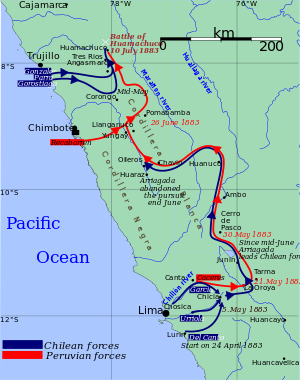Battle of Huamachuco
| Battle of Huamachuco | |||||||
|---|---|---|---|---|---|---|---|
 The long way to the Battle of Huamachuco |
|||||||
|
|||||||
| Belligerents | |||||||
|
|
|
||||||
| Commanders and leaders | |||||||
|
|
|
||||||
| Strength | |||||||
| 1.500 | 1.440 plus hundreds of montoneras | ||||||
| Casualties and losses | |||||||
| 68 dead 96 wounded |
800 dead and 300 captured | ||||||
The Battle of Huamachuco was fought on July 10, 1883, and it was the last major battle of the War of the Pacific. The Chilean soldiers led by Colonel Alejandro Gorostiaga decisively defeated the Peruvian army commanded by General Andrés Avelino Cáceres near the town of Huamachuco. This Chilean victory effectively eliminated Cáceres' Ejército de la Breña, ending any real threat or resistance in the Peruvian Andes. The Peruvian defeat paved the way for the Treaty of Ancon that finally put an end to the war. Also, one of Peru's greatest heroes, Colonel Leoncio Prado, died as a consequence of this battle.
The defeats suffered by the Chilean Army at Marcavalle, Pucará and Concepcion, in addition to the decimation of their troops due to poor sanitation, convinced the Chilean High Command of the need to completely abandon the Central Andes. This retreat was made possible by the Chilean victory at Tarma Tambo on July 15, 1882. By that time, the occupation troops had been reduced to about half their original size. Peruvian General Andrés Cáceres controlled the Mantaro valley and had even briefly possessed the city of Huancayo. He established his command in Tarma and busied himself reorganizing his army. By January 1883, Cáceres had raised his troops to 3,200 well-armed and equipped men, and commanded central Peru.
Faced with this threat to the peace negotiations, Admiral Patricio Lynch, the Chilean Commander-in-Chief, decided to send a new force against General Cáceres. This new army comprised three divisions, under the command of Colonels García, del Canto and Arriagada. The Chilean army was well armed, and had learned the lessons of previous forays into the high Andes. Their plan was to surround and corner the Peruvians to force them into a conventional battle. Soon after they captured the strategic city of Jauja and on May 5 they reunited the forces in the city of Chiqlla. Faced with this grave threat, the Peruvian army retreated north.
On May 30 the Peruvian army arrived at Cerro de Pasco, with the Chilean divisions under Colonels del Canto and García in close pursuit. Under those circumstances, the Peruvians continued to retreat into the high Andes. By the third week of June the Peruvians were in critical condition as the Chileans had almost cornered them. On June 22 General Cáceres ordered a retreat via the Llankanuku pass, located at an altitude of over 6,000 meters and some 200 km (125 mi) north-west of Cerro de Pasco. Thanks to this risky maneuver he managed to evade the main Chilean force.
...
Wikipedia
